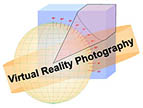 | Fields of View and Pan Increments |
Most panoramic stitching software applications perform best when there is a 1/3 to 1/2 frame overlap between adjacent images in a panoramic sequence. This is not a hard and fast rule however. Think of it as a general rule of thumb, rather than an absolute requirement when shooting.
A minimum overlap between shots is necessary in order for the software stitchers to properly match pixel patterns and blend the images together with no apparent seam. The smaller this overlap, the fewer pixels are available for pattern matching and the narrower the blend area will be. On the other hand, too much overlap means unnecessary duplication of data and slows the stitching process significantly.
In the early days of QuickTime VR panoramic photography, Apple recommended shooting 12 shots per 360° panorama (30° increments between shots) with a 15mm rectilinear Nikkor lens on a 35mm Nikon camera (in vertical or portrait mode). This actually provided about a 60 percent overlap between shots – significantly more than was necessary. However, the reason for this was that it allowed you to skip an image during stitching and still have sufficient overlap between every other shot. This was often necessary because of the relatively high susceptability of the 15mm Nikkor to lens flare. Rather than stitching an image into the panorama which would require extensive Photoshop retouching later on, it was often preferred to skip that inferior shot. Stitching 15mm shots with a 60° pan increment between them still left about a 20 percent overlap, which was adequate (albeit somewhat limited) for successful image pair matching.
The chart below offers a guide for determining field of view (fov) for a variety of lenses used with 35mm film cameras. The field of view recorded depends upon both the focal length/design of the lens, and the size of the image area it is projected onto. Since many digital cameras use image sensors that are smaller than a 35mm film frame (resulting in cropping of the image), the images captured with these 35mm format lenses will have smaller fields of view than listed. Most digital camera manufacturers will offer a "35mm equivalent" focal length for their lenses, or else a conversion factor for multiplying the focal length in order to get the approximate equivalent for their camera.

 Fields of View - VR Photography
Fields of View - VR Photography

 Film format: 35mm (Nikon, Canon, Leica, etc.)
Film format: 35mm (Nikon, Canon, Leica, etc.)
Notes:
1) Lenses used must be rectilinear (corrected, or non-fisheye).
2) Assumes images are captured with camera in portrait (vertical) orientation.
3) Actual fovy settings used in stitching software are likely to be smaller than calculated here due to cropping in the scanning or digital capture process.
4) Field of view (fov) calculations are done as follows:

 fov = 2 * tan-1(image size / (focal length * 2))
fov = 2 * tan-1(image size / (focal length * 2))
5) Lens manufacturers generally list the diagonal field of view of their lenses in their product literature, rather than the vertical field of view (fovy) required by most stitching applications.


Those who use a variety of lenses for their panoramic photography but don't want to have to change detent settings on their pan head, are likely to find a 24-detent arrangement will provide the most flexibility. This allows you to work with almost all lenses of 50mm focal length and shorter. Simply skip clicks as you pan to get your needed combinations.
With 24 detents, each click represents 15° of pan (24 shots per 360° panorama). To shoot in 30° increments (12 shots), skip every other click. For 45° increments (8 shots), shoot from every third detent. For 60° increments (6 shots), move four clicks between shots, etc.


 Fields of View - VR Photography
Fields of View - VR Photography